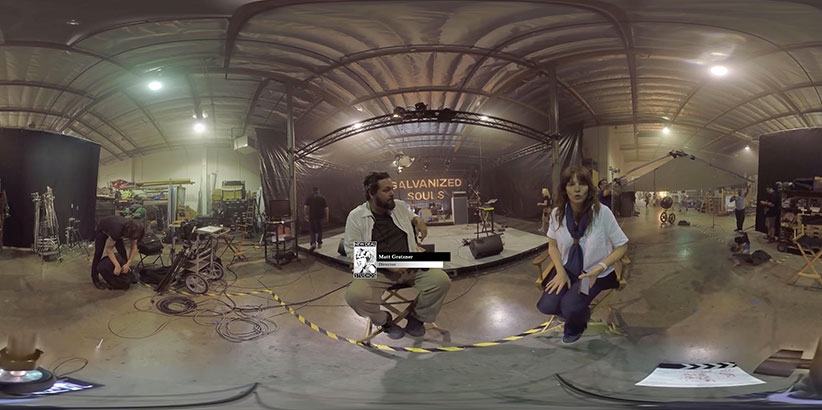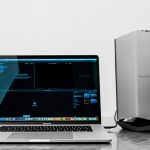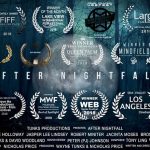
The Art of Telling Stories
Filmmaking is filmmaking, whether it’s a traditional production or a piece destined for use in a VR context, and Vanishing Point Media has used its experience of the former to move across to the latter.
Annie Lukowski, one half of Hollywood-based Vanishing Point Media (VPM), is quick to respond when asked why she and business partner BJ Schwartz decided to make the brave move from conventional filmmaking to throw themselves into the embryonic, and far more unpredictable, world of 360° and VR production.
“We did it because we’re insane masochists and were looking to combine all the problems of an independent production company with the headaches that come with a technology start-up,” she tells me, with the straightest of straight faces. That’s a joke, right? Ok, yes it is but, as Annie reminds me, sometimes jokes are funny “because they have just that little element of truth about them…”
The pair have made a lurch sideways into an area where there’s very little in the way of rules and regulations, simply because all of those involved to date are pioneers who are finding out the hard way what works and what doesn’t. But someone has to be first in, and by leading from the front VPM has established itself as one of the leading exponents of the VR revolution, and the reward has been some amazing cutting-edge commissions that have been a heady mix of enormous fun and the steepest of steep learning curves.
“Honestly, we still very much consider ourselves filmmakers,” says Annie. “We just happen to be focusing on telling immersive stories in VR Head-Mounted Displays (HMDs) right now. BJ and I met at USC film school in Los Angeles where we were the exclusive members of a two-person mutual admiration club, and yet, somehow, we never quite got to work together in a major way. After that we went our separate ways for a while before getting together to work on a feature script.
“While that was in progress, we were contacted by a mutual friend – the remarkable Shannon Gans of New Deal Studios – who wanted us to take a look at VR narrative and to consider collaborating with her on developing some serialised content for HMDs. As flawed and as limited as the tech was back in 2014, we instantly saw the huge potential for telling stories.”
To make a long story short, Annie and BJ dived in head first, quickly realising how much they had to learn before even trying to write a script for a VR experience. “The medium can have similarities to theatre and film,” says Annie, “while at other times it reminded us of classic radio programming. In short, it was a genuinely unique medium, so we needed to bank some hours with the technology to learn what kind of stories and storytelling would live well in an HMD.

Annie Lukowski and BJ Schwartz took a brave leap into the unknown world of video production when they set up Vanishing Point Media.

“As flawed and as limited as the tech was back in 2014, we instantly saw the huge potential for telling stories”
“The first stop was to buy an Oculus DK2 and try to use video games like Alien Isolation to brainstorm about framing and to explore emotional connection. Robots in that game will follow you around so we used that ‘feature’ to create primitive storyboards to share with each other. Obviously, that only went so far, and before long we found ourselves the owners of a ten-camera GoPro rig and a computer capable of stitching together small experiments in VR narrative.”
In the filmmaking world things have a habit of developing their own momentum, and once word got out that Annie and BJ had a VR rig jobs organically started to come their way. Now a name was needed: “We knew the company would always be driven by tech just beyond the horizon,” says Annie, “so Vanishing Point Media seemed appropriate.”
Getting a Grip on Geard
Both Annie and BJ are self-confessed ‘big nerds’ with regard to traditional filmmaking technologies, something they consider was a prerequisite for the VR adventure they find themselves on. Being fluent with such things as digital codecs, understanding editing systems and having a working knowledge of sound capture technology and optics were all things that helped ease the move into new technology, and it was also useful to have a traditional narrative background and an understanding that all tech is supposed to be invisible.
“The technology gets the story to the audience,” says Annie. “It’s not, in itself, the story. Losing sight of that can be easy when you’re working in a brand new medium. You could, for example, imagine there’s a single camera out there that’s the best for all situations because it has some shiny new feature. The truth is, as in traditional filmmaking, that camera and other cinematographic choices should always be rooted in story, while being constrained, of course, by budget.
“We love the Jaunt ONE for low light situations, but it’s huge and hard to move. An alternative is the light Z-Cam S1 Pro, which only has four stitch lines. In our narrative experience The Hidden we used the Nokia Ozo because we had to shoot in small spaces, had a long tracking shot and really liked the look for the hyper-real feeling we were trying to evoke. By the time it was discontinued – with various software and firmware improvements – the Ozo had come into its own as a phenomenal camera, and we mourn its passing.
“As a team, we have a single, iron-clad rule in terms of kit for VR. Namely, try it: nobody has enough experience to guess in this medium. If your client doesn’t want to invest in a test-shoot, push back. There are concerns you won’t think of with every unit and you won’t know what you’re up against until you’ve shot with it.”

The slices of fashion shoot for Banana Republic showed what could be done with VR.
“The technology gets the story to the audience; it’s not, in itself, the story”
Coming of Age
While this might still constitute early days for VR and 360° filmmaking, VPM is already proving that both have rock solid commercial viability, having taken on several high-profile commissions which have fully explored the potential of these mediums.
One in particular, for fashion outlet Banana Republic, was a production that was very much exploring what a conventional advertising film might be trying to do but in a way that had been reconfigured for a more immersive treatment. In a really clever piece of filmmaking, a model is seen walking between segments, the clothes she’s wearing changing as she moves from one to the other with the viewer in control and able to look around the scene at will as the commercial is progressing.
“This was a really fun shoot to do,” says Annie. “It looks great in a headset but the target we were asked for was online, namely Facebook 360 video. So, first and foremost, the video had to play well on a desktop with mouse navigation and on the phone. In consultation with the client, we arrived at the idea of producing 360° ‘slices’ of downtown Charleston, through which a model would move seamlessly while donning several different summer dress looks.
“We shot each slice on a Sony PXW-FS5 turned on its side to get as much vertical capture as possible. We then took footage at several different positions to get material to use in constructing the sky and ground, using special tools found in After Effects.”

The campaign for Toyota was more traditionally shot but felt exciting.
While other clients still need to be encouraged to follow suit, the success of this project did open eyes and it has brought fresh commercial work through the door. There have also been more traditional VR-type projects to work on, such as a campaign for Toyota that looked to change the perception of the Camry, one of its models that was seen as being a rather dull family saloon. The Toyota: Thrill Ride was based around a high-speed driving experience, with the viewer wearing a headset and taking up a position inside the car. The four-minute film gave the impression of the ride and was used extensively in Toyota dealerships to give potential purchasers a feel for what the car is capable of.
“The film plays in Toyota’s own Unity-created app,” says Annie. “The primary cameras we used were four Z-cams and three Kandao Obsidians, and these were mounted all over the car. Our external mounts included hostess tray, hood mount, wheel-well mount, and a trunk mount that was boomed up to suspend the camera above the car. All these mounts needed to be super secure so were triple secured so that the camera didn’t shake and make the viewer nauseous.
The crash (dashboard) cameras were 3D Vuzes, and we had a few of these on the track so that the car drives over them, and there were also a few on sticks placed throughout the track. We were looking for some really close call shots that would help to ramp up the excitement of the ride.”
Another high profile piece of VR work was carried out for the Jimmy Kimmel late night chat show, with the idea that a viewer would get a feel for the full on experience of being a guest on the show. “In the end, the target audience – Jimmy Kimmel fans – excitedly shared the experience with friends and loved ones and seemed to be fully engaged,” says Annie. “The feedback was phenomenal and most gratifying of all was one fan’s comment: ‘Look! I got to be a guest on Jimmy Kimmel and that’s more than I can say for Matt Damon!’ That kind of stuff really melts our hearts.”

“There’s still a huge appetite to learn more about VR”

As for the future, Annie is realistic about the barriers that still have to be overcome before VR and 360° technology becomes mainstream. “A lot of the issues that exist are down to Return on Investment (ROI),” she says. “In the narrative space it’s tricky because there isn’t a premium or paywall channel and the major streaming services have yet to fully embrace the medium. In the advertising/promotional/branded space many projects were getting funded based on press potential. VR projects were getting a lot of ink and brands were excited by that momentum, but this has slowed down as the novelty wears off.
“But there’s still a huge appetite out there to learn more about VR and to experience it. We see our job as helping clients find opportunities to turn that appetite into exposure. Lately, we’ve been stressing that small-scale and relatively inexpensive VR installations can go a long way towards helping promote brick-and-mortar sales in the age of Amazon. The very fact that VR hasn’t penetrated the home market but is becoming more and more inexpensive is a huge opportunity.”
There is no doubt that VR is still in its relative infancy, but those at the cutting edge, such as Vanishing Point, are doing their best to promote the technology and to educate commercial clients regarding the possibilities that exist for this kind of immersive effect. Those that are in at the beginning stand to benefit the most.
“We’d love to do more work along the lines of the Toyota campaign, and the potential is limitless,” says Annie. “Just think about how you choose a bottle of wine and now imagine there’s a headset hanging next to a certain bottle in the store. Do you put it on and check out the vineyard? We think you do.
“In the meantime, we’re still in a very exciting place. It can be exhausting to be the beta-testers on all this tech and to navigate a marketplace that’s only just emerging. But we get to make and discover the rules for a brand new mode of storytelling. What could be better than that?”
For more information visit: vanishingpointvr.com










